Stir-fried tofu skin, or doufu pi in Mandarin, is a beloved dish in Chinese cuisine that celebrates simplicity, texture, and bold flavors. Often overlooked in Western kitchens, this vegan-friendly ingredient offers a chewy, slightly springy texture that absorbs sauces beautifully, making it a canvas for umami-rich seasonings. Whether you’re a seasoned home cook or a curious food enthusiast, mastering the art of stir-fried tofu skin will reward you with a dish that’s both satisfying and deeply satisfying. This article will guide you through the process, from selecting the finest ingredients to achieving the perfect balance of heat, sweetness, and tanginess.
Understanding Tofu Skin: A Brief Introduction
Tofu skin, also known as yuba in Japanese, is a byproduct of soy milk production. When soy milk is heated, a thin film forms on its surface—this film is carefully lifted and dried to create sheets of tofu skin. Rich in protein, low in calories, and versatile in application, tofu skin has been a staple in Asian cooking for centuries. It can be enjoyed fresh, dried, or fried, and its ability to absorb flavors makes it ideal for stir-fries, soups, and even wraps.
For stir-frying, dried tofu skin is often rehydrated to restore its pliable texture. However, fresh tofu skin (available in some Asian markets) can be used directly. The key to a great stir-fry lies in preparing the tofu skin correctly and pairing it with complementary aromatics and seasonings.
Ingredients: Building Blocks of Flavor
To create a memorable stir-fried tofu skin dish, gather the following ingredients. Quantities are adjustable based on personal preference, but the ratios below strike a harmonious balance.
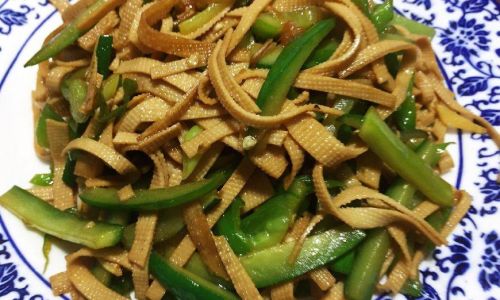
For the Tofu Skin and Vegetables:
- 200g dried tofu skin (or 400g fresh tofu skin)
- 1 medium carrot, julienned
- 1 red bell pepper, thinly sliced
- 50g wood ear mushrooms, rehydrated and sliced (optional)
- 3 garlic cloves, minced
- 1-inch ginger, grated
- 2-3 dried red chilies, crushed (adjust to taste)
- 3 scallions, white and green parts separated, chopped
- 1/4 cup roasted peanuts (for garnish, optional)
For the Sauce:
- 2 tbsp light soy sauce
- 1 tbsp dark soy sauce (for color)
- 1 tbsp oyster sauce (or vegetarian oyster sauce)
- 1 tbsp rice vinegar
- 1 tsp sugar
- 1/2 tsp white pepper
- 1/4 cup water or vegetable broth
- 1 tbsp cornstarch (mixed with 2 tbsp water for slurry)
For Cooking:
- 3 tbsp cooking oil (peanut or vegetable oil preferred)
- 1 tsp sesame oil (for finishing)
Preparation: The Foundation of Excellence
Rehydrating Dried Tofu Skin:
If using dried tofu skin, soak it in warm water for 15–20 minutes until soft and pliable. Gently squeeze out excess water, then cut into 2-inch-wide strips. Avoid over-soaking, as this can make the tofu skin mushy.
Prepping Vegetables:
Julienne the carrot into thin, even strips. Slice the bell pepper into thin strips. Rehydrate wood ear mushrooms in hot water for 10 minutes, then drain and slice. Mince garlic and ginger finely. Separate scallion whites (for cooking) and greens (for garnish).
Mixing the Sauce:
In a small bowl, whisk together light soy sauce, dark soy sauce, oyster sauce, rice vinegar, sugar, white pepper, and water. Set aside. The cornstarch slurry will be added later to thicken the sauce.
Cooking Technique: The Dance of Wok and Heat
Stir-frying is a high-heat, quick-cooking method that preserves texture and flavor. Achieving the perfect sear and even cooking requires attention to detail.
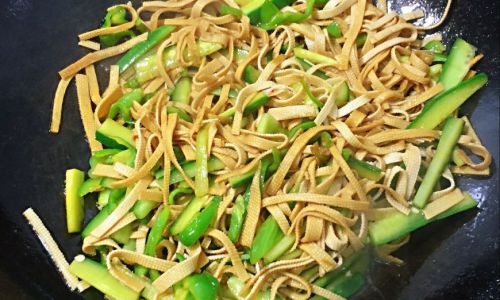
Heating the Wok:
Place your wok or large skillet over high heat. Allow it to smoke lightly before adding oil. This ensures the wok is hot enough to sear ingredients without steaming them.
Aromatics First:
Add 2 tbsp of cooking oil to the wok. Swirl to coat the surface. Toss in crushed dried chilies, minced garlic, and grated ginger. Stir-fry for 10–15 seconds until fragrant but not browned.
Adding Vegetables:
Add the carrot strips and stir-fry for 1 minute. Follow with bell peppers and wood ear mushrooms. Stir-fry for another 2 minutes until vegetables are crisp-tender. Vegetables should retain their vibrant colors and a slight crunch.
Introducing Tofu Skin:
Push the vegetables to one side of the wok. Add the remaining 1 tbsp of oil to the empty space. Add the tofu skin strips and let them sear undisturbed for 30 seconds. Toss gently to combine with vegetables.
Sauce and Simmer:
Pour the prepared sauce over the ingredients. Stir-fry for 1–2 minutes to coat everything evenly. Add the cornstarch slurry and stir continuously until the sauce thickens (about 30 seconds). The sauce should cling to the tofu skin and vegetables without being gloppy.
Final Touches:
Drizzle with sesame oil and toss in the scallion greens. Remove from heat immediately to prevent overcooking.
Serving Suggestions: Elevating the Dish
Stir-fried tofu skin is incredibly versatile. Serve it as:
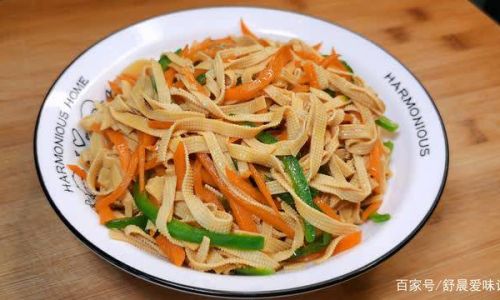
- A standalone main dish with steamed jasmine rice or brown rice.
- A side dish alongside grilled meats or tofu.
- A filling for lettuce wraps for a low-carb option.
- A topping for noodles (try mixing with chow mein or udon).
Garnish with roasted peanuts for crunch, sesame seeds, or a sprinkle of chili flakes for extra heat. A squeeze of fresh lime juice just before serving adds a bright acidity that cuts through the richness.
Variations and Customizations
One of the joys of stir-fried tofu skin is its adaptability. Experiment with these twists:
- Protein boost: Add diced chicken, shrimp, or fried tofu cubes.
- Spice levels: Adjust chili quantities or swap dried chilies for fresh bird’s eye chilies.
- Vegetable swap: Use snap peas, mushrooms, or baby corn instead of carrots.
- Nut-free option: Omit peanuts and use toasted sunflower seeds.
Common Mistakes and How to Avoid Them
-
Overcooking Tofu Skin:
Tofu skin becomes rubbery if overcooked. Add it to the wok only after vegetables are partially cooked and stir-fry briefly. -
Inconsistent Sauce:
Mix the cornstarch slurry just before adding to avoid lumps. Adjust sauce thickness by adding more water (for thinner) or cornstarch (for thicker). -
Lack of Aroma:
Searing aromatics like garlic and ginger is crucial. Avoid burning them by keeping heat high but stirring constantly. -
Crowding the Wok:
Overcrowding lowers the wok’s temperature, leading to steaming instead of searing. Cook in batches if necessary.
Health Benefits: Nutrition Meets Flavor
Tofu skin is a nutritional powerhouse. A 100g serving provides:
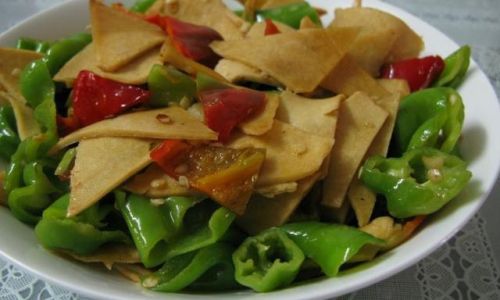
- 18g protein: Ideal for vegetarians and vegans.
- Rich in iron and calcium: Supports bone health and circulation.
- Low in saturated fat: A heart-healthy alternative to meat.
Paired with vegetables, this dish offers fiber, vitamins, and antioxidants, making it a well-rounded meal.
Cultural Context: Tofu Skin in Chinese Cuisine
Tofu skin has deep roots in Chinese culinary history. Its origins trace back to the Han Dynasty (206 BCE–220 CE), where it was prized for its long shelf life and versatility. In Buddhist cuisine, it’s a popular meat substitute, while in home kitchens, it’s cherished for its ability to transform simple ingredients into comforting meals.
Conclusion: A Dish Worth Mastering
Stir-fried tofu skin is more than a recipe—it’s a testament to the magic of umami, texture, and balance. With practice, you’ll learn to adjust seasonings, experiment with ingredients, and even develop your signature twist. Whether you’re cooking for a weeknight dinner or impressing guests, this dish delivers on flavor, health, and visual appeal. So grab your wok, embrace the sizzle, and let the humble tofu skin become a star on your table.
Final Tip: Leftovers taste even better the next day, as the flavors meld. Store in an airtight container and reheat gently in a pan with a splash of water to revive the texture. Happy cooking!
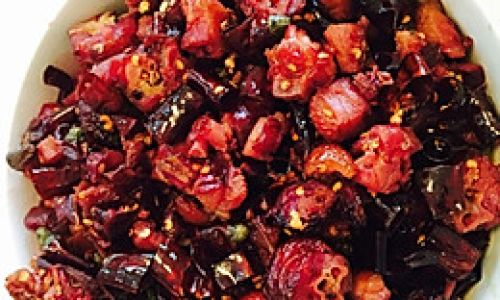

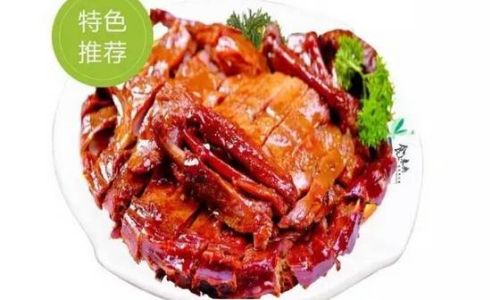



0 comments